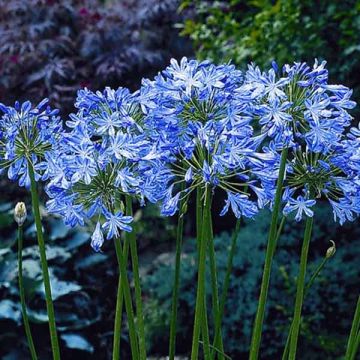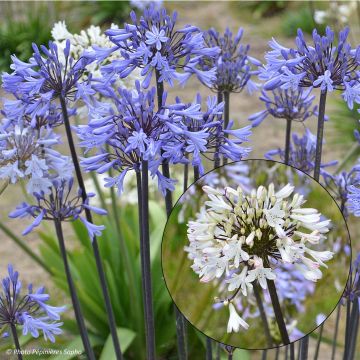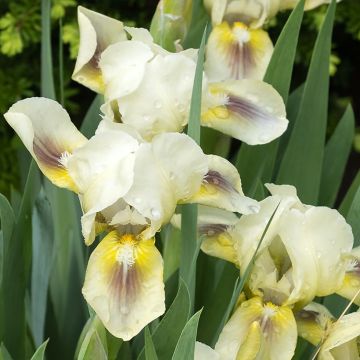

Agapanthe Silver Baby
Agapanthus Silver Baby
Agapanthus Silver Baby
African Lily, Lily of the Nile
This item cannot be shipped to the selected country
Delivery charge from €5.90
More information
Schedule delivery date,
and select date in basket
This plant carries a 12 months recovery warranty
More information
We guarantee the quality of our plants for a full growing cycle, and will replace at our expense any plant that fails to recover under normal climatic and planting conditions.
From €5.90 for pickup delivery and €6.90 for home delivery
Express home delivery from €8.90.

Does this plant fit my garden?
Set up your Plantfit profile →
Description
Agapanthus 'Silver Baby' is, as its name suggests, a small specimen with very pretty flowers with a romantic look: they are white, infused with blue on the edges of the petals, the whole is slightly grey, giving this silvery impression. It is a hybrid Agapanthus that is not very hardy, up to about -10°C (14°F) ideal for borders in mild regions and in pots. Its semi-evergreen foliage is fine, of a beautiful light green. It forms a clump from which rigid and robust stems emerge, flowering from June to September. It does not exceed 40 to 50cm (16 to 20in) in height.
Agapanthus are plants of the lily family, originating from South Africa, which hybridize naturally in nature or in our gardens. Agapanthus 'Silver Baby' is a hybrid cultivar that received a Garden of Merit Award in 2019, a distinction awarded by the Royal Horticulture Society. This plant develops and multiplies rapidly from a stump with fleshy rhizomes, forming a dense clump of linear, narrow, bright green foliage. The abundant flowering takes place in summer, more or less early depending on the climate, and lasts about 6 weeks. Solid and stout stems, about 30cm (12in) high, bear at their tips hemispherical umbels composed of about twenty small campanulate flowers, white-grey, whose petals are terminated by bluish tips.
Agapanthus 'Silver Baby' is a lovely variety to integrate in a white garden, among grey foliage. It brings an exotic and light touch to sunny borders. This semi-hardy variety should be placed in a protected and south-facing location, and a thick mulch should be applied at its base. Whether in a border, in a pot or in a planter, Agapanthus 'Silver Baby' suits various settings. It is particularly suited to mild coastal climates. In harsher regions, it is perfect in a pot to be stored away each winter. It is very beautiful when associated with other mauve or blue varieties in a minimalist decor. It is also very decorative in romantic-themed beds with Hemerocallis, Bush Salvias or Gauras.
Report an error about the product description
Agapanthus Silver Baby in pictures


Flowering
Foliage
Plant habit
Botanical data
Agapanthus
Silver Baby
Alliaceae - Liliaceae
African Lily, Lily of the Nile
Cultivar or hybrid
Other Agapanthus - Lily of the Nile
Planting and care
Plant Agapanthus 'Silver Baby' stumps by covering them with at least 10cm (4in) of good soil, this way they withstand the cold better. It is essential to install them in spring and mulch them in winter. For pot cultivation, use 5 young plants for a 24cm (9in) pot and protect your pots in winter. They prefer a rich and moist, but well-drained soil, enriched with sand. Water them regularly during the growth period (twice a week). However, avoid watering them afterwards. They fear winter moisture excess. This variety particularly thrives in containers. Use a well-drained sandy mixture, slightly acidic. This plant seems to prefer shallow containers and will flower abundantly if regularly fed with slow-release fertilizer.
Planting period
Intended location
Care
This item has not been reviewed yet - be the first to leave a review about it.
Mediterranean perennials
Haven't found what you were looking for?
Hardiness is the lowest winter temperature a plant can endure without suffering serious damage or even dying. However, hardiness is affected by location (a sheltered area, such as a patio), protection (winter cover) and soil type (hardiness is improved by well-drained soil).

Photo Sharing Terms & Conditions
In order to encourage gardeners to interact and share their experiences, Promesse de fleurs offers various media enabling content to be uploaded onto its Site - in particular via the ‘Photo sharing’ module.
The User agrees to refrain from:
- Posting any content that is illegal, prejudicial, insulting, racist, inciteful to hatred, revisionist, contrary to public decency, that infringes on privacy or on the privacy rights of third parties, in particular the publicity rights of persons and goods, intellectual property rights, or the right to privacy.
- Submitting content on behalf of a third party;
- Impersonate the identity of a third party and/or publish any personal information about a third party;
In general, the User undertakes to refrain from any unethical behaviour.
All Content (in particular text, comments, files, images, photos, videos, creative works, etc.), which may be subject to property or intellectual property rights, image or other private rights, shall remain the property of the User, subject to the limited rights granted by the terms of the licence granted by Promesse de fleurs as stated below. Users are at liberty to publish or not to publish such Content on the Site, notably via the ‘Photo Sharing’ facility, and accept that this Content shall be made public and freely accessible, notably on the Internet.
Users further acknowledge, undertake to have ,and guarantee that they hold all necessary rights and permissions to publish such material on the Site, in particular with regard to the legislation in force pertaining to any privacy, property, intellectual property, image, or contractual rights, or rights of any other nature. By publishing such Content on the Site, Users acknowledge accepting full liability as publishers of the Content within the meaning of the law, and grant Promesse de fleurs, free of charge, an inclusive, worldwide licence for the said Content for the entire duration of its publication, including all reproduction, representation, up/downloading, displaying, performing, transmission, and storage rights.
Users also grant permission for their name to be linked to the Content and accept that this link may not always be made available.
By engaging in posting material, Users consent to their Content becoming automatically accessible on the Internet, in particular on other sites and/or blogs and/or web pages of the Promesse de fleurs site, including in particular social pages and the Promesse de fleurs catalogue.
Users may secure the removal of entrusted content free of charge by issuing a simple request via our contact form.
The flowering period indicated on our website applies to countries and regions located in USDA zone 8 (France, the United Kingdom, Ireland, the Netherlands, etc.)
It will vary according to where you live:
- In zones 9 to 10 (Italy, Spain, Greece, etc.), flowering will occur about 2 to 4 weeks earlier.
- In zones 6 to 7 (Germany, Poland, Slovenia, and lower mountainous regions), flowering will be delayed by 2 to 3 weeks.
- In zone 5 (Central Europe, Scandinavia), blooming will be delayed by 3 to 5 weeks.
In temperate climates, pruning of spring-flowering shrubs (forsythia, spireas, etc.) should be done just after flowering.
Pruning of summer-flowering shrubs (Indian Lilac, Perovskia, etc.) can be done in winter or spring.
In cold regions as well as with frost-sensitive plants, avoid pruning too early when severe frosts may still occur.
The planting period indicated on our website applies to countries and regions located in USDA zone 8 (France, United Kingdom, Ireland, Netherlands).
It will vary according to where you live:
- In Mediterranean zones (Marseille, Madrid, Milan, etc.), autumn and winter are the best planting periods.
- In continental zones (Strasbourg, Munich, Vienna, etc.), delay planting by 2 to 3 weeks in spring and bring it forward by 2 to 4 weeks in autumn.
- In mountainous regions (the Alps, Pyrenees, Carpathians, etc.), it is best to plant in late spring (May-June) or late summer (August-September).
The harvesting period indicated on our website applies to countries and regions in USDA zone 8 (France, England, Ireland, the Netherlands).
In colder areas (Scandinavia, Poland, Austria...) fruit and vegetable harvests are likely to be delayed by 3-4 weeks.
In warmer areas (Italy, Spain, Greece, etc.), harvesting will probably take place earlier, depending on weather conditions.
The sowing periods indicated on our website apply to countries and regions within USDA Zone 8 (France, UK, Ireland, Netherlands).
In colder areas (Scandinavia, Poland, Austria...), delay any outdoor sowing by 3-4 weeks, or sow under glass.
In warmer climes (Italy, Spain, Greece, etc.), bring outdoor sowing forward by a few weeks.























































